When Tiger Moths Attacked Cabbage Patches
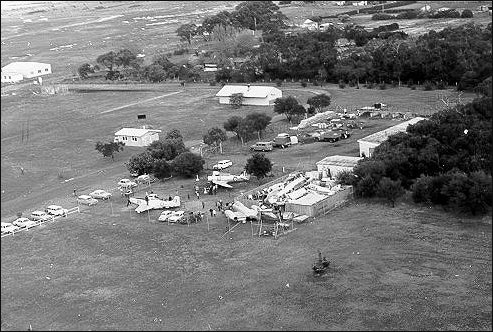
Aerial view of Moorabbin Airport c1960. Showing the beginning of the Moorabbin Airport Museum. Leader Collection.
Prime Minister Ben Chifley’s last announcement of any great importance to the people of Moorabbin and Mordialloc was made on November 7, 1946. It came via the pages of the Mordialloc News. Before that the burghers of both municipalities had no idea of what was about to happen. The Prime Minister stated that the Government was about to acquire a large tract of land in the Parish of Mordialloc at a cost of £140,000 pounds ($280,000) on which it would construct a secondary airport for Melbourne. Work was to start immediately.
Absence of an exact location soon gave rise to speculation among Mordialloc residents; some said the PM was taking their past interest in aviation for granted. Mordialloc’s Epsom racecourse had been the site on which Australia’s first aerial derby had been staged in 1920. More recently, during World War Two, a Victorian Air Observation Corps (VAOC) emergency landing strip had operated. The Mordialloc-based VAOC had guided an American Mitchell bomber to a safe landing at Essendon and a DC2 of the Australian National Airlines to the ANA strip near Wells Rd. Although the DC2 landed safely, the VAOC members, in their enthusiasm, backed their truck into the wing of that machine. Before the VAOC came into existence (in February 1941) a Royal Australian Air Force Wapiti made a forced landing on the paddock behind Epsom racecourse. Mordialloc residents appeared on the scene to help the uninjured pilot from his damaged aircraft. And so it went on and on like an airmen’s social night but with Mordialloc citizens being more than ever convinced that Chifley had no right to buy up land for an airport in the Parish of Mordialloc without consulting the people first.
At the next meeting of the City of Mordialloc Citizens League (MCL), most general business was brushed aside to discuss the “Proposed Mentone Airport". The MCL consisted of the keenest and most energetic members of the Mordialloc community that ever came together in the interest of that fair city. President of the league was E. J. Trait (better known as “Eddy"), the editor-in-chief of Standard News. Secretary was Les Morris, a man who instigated many progressive moves in Mentone and Mordialloc. The MCL was a formidable force to be reckoned with. So much so that it was often referred to as the “Upper House" of Mordialloc Council. Its members met on the crucial airport issue only to hear reports that the government was about to take over Epsom racecourse and the Woodlands golf links to establish the Mentone Airport. If this turned out to be true, league members decided to fight against the proposal for all they were worth.
A letter questioning these allegations and asking why the MCL and Mordialloc Council had not been informed of the government’s intentions, was promptly despatched to Sir Richard “Dickie" Williams, director of the Department of Civil Aviation. Sir Richard was an airman of the Harry Hawker era; the type of man who thought so much of aviation that he would never let it interfere with the amenity of the people. Courteously he replied to the MCL stating that their racecourse and golf links were quite safe and that the presence of an airport would make it more convenient for faraway patrons who could fly to within five minutes drive of either. He also stated that although the airport was in the Parish of Mordialloc it was located in the City of Moorabbin.
The MCL committee, satisfied that the airport was none of their business, turned their attention to matters closer to home and handed over to Moorabbin Council a petition signed by a few Mordialloc residents protesting against the noise that might eventuate should an airport be established. By this time Moorabbin people who held market garden properties close to the landing field realised that their real problem rested in the compensation price the government was prepared to pay for land acquisition. This brought about the formation of the Cheltenham Airport Protection League which consisted of several market gardeners and poultry farmers who suspected that the government was going to take over their property and give them practically nothing in return. Most of its members lived in Heatherton and the meetings were held in Heatherton Hall.
Local progress associations preferred not to be associated with the question of the airport; in one way it was considered to be none of their business. At the same time many of the newcomers who had come to live in Moorabbin had joined progress movements with a view to having better amenities provided. But among them were numerous aviation enthusiasts who had shifted house to be near the airport. The people with a dispute against the establishment of an airport were those with little or no faith in the officers who handled compulsory land acquisitions on behalf of governments. They had already seen how the Victorian Housing Commission was riding roughshod over small land holders at Highett. Under emergency powers, the commission payed as little as possible and owners had no right of refusal. The commission even built flats on the Highett land despite a council ruling against flats in Moorabbin.
What angered the Heatherton people more than anything, however, was the arrival of work parties to knock down fences, bulldoze trees and sweep away vegetable crops without any official notice being served upon them to say that their land would be acquired. It was virtually an attack on cabbage patches to make way for the Tiger Moths that were to be stationed at Moorabbin Airport. Then, adding insult to injury, came rates notices asking them to pay rates on the properties being flattened by the government workforce. The rate collector reported the anomaly to council. Said town clerk Wilson Begg Thomas “The position of rate payments in connection with the properties in the Moorabbin Airport area is surrounded by glorious uncertainty in which the dispossessed owners find themselves at the present time." A council committee was formed which consisted of Crs Le Page, Marriott and Allnutt. Their duty was to look into the matter and report back to council.
Meanwhile, the Cheltenham Airport Protection League (CAPL) wrote to Sir Richard Williams asking why Cheltenham had been chosen for the siting of the airport. Sir Richard pointed out numerous reasons but said the main ones were the remoteness from houses and the suitability of the land for that purpose. The league then sent a reply to items listed by Air Vice-Marshal Williams stating those it agreed with and those it could not see eye to eye on. One thing the league did not agree with was the site selected; it felt that nearer Wells Rd. would have been more suitable. In July 1948, CAPL members were still complaining bitterly about the government’s neglect to give some notification of the acquisition of their land. They were anxious to rehabilitate themselves but had no money with which they could so. For 12 months they had been complaining about the noise of airport construction machinery and the waves of dust making their homes near unfit to live in.
Now the urgency for payment of compensation was overshadowing everything and while not one person had by then received a money settlement it was already known that the opening date was set for that month. Somehow the airport did not open in July and an explanation was given that difficulty was being experienced in getting grass to grow. Apparently grass was planted four inches deep across the airfield and oats scattered over the surface, but the grounds produced a fine crop of oats which choked out the grass. Yet the news at the end of the month was much better for the local residents than it was for the Department of Civil Aviation; at last a government official inspected the properties that had been taken over. He advised the owners that settlement was near and warned that any crops planted after his visit would not be compensated for CAPL then appears to have gone into oblivion as all publicity relating to its activities faded out.
The delayed opening date was still unknown by April 1949. There was rumour that Prime Minister Ben Chifley was stalling off for a day nearer to the Federal election which was due later that year. But as one anxious airman put it: “Our Ben might be a good railway engine driver but if he ever flew an aeroplane he would soon be told that an inexperienced airman who stalls is well on his way to a nasty crash."
Another pilot who has just purchased an RAAF Wirraway, wondered what all the delay was about and set out to conduct his own investigation. Coming from Essendon he followed Port Phillip Bay using the gasometers at Brighton and Highett as landmarks and then picked out the old HMVS “Cerberus" at Half Moon Bay. Turning left he followed Balcombe Road to where it crossed the Nepean Highway and became Lower Dandenong Road. and found the landing field to the port-side of his machine. Circling the airport for a time he assured himself that the field was ready to receive the weight of an aeroplane and after a gentle turn over the Kingston Heath Golf Links steered his machine to a perfect three point landing. As suggested by the “Moorabbin News", this did not mean that the airport was then opened, as the Wirraway was escorted to a hangar where it was expected to remain for some time.
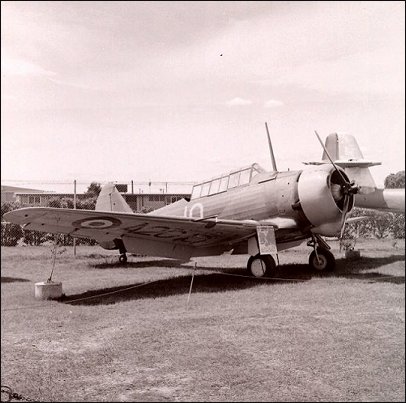
Wirraway at the Moorabbin Airport Museum, 1975. Leader Collection.
Fortunately, Moorabbin Airport was designed to accommodate any plane up to the weight of the DC3 (Douglas Commercial 3) or its army counterpart which was the Dakota. Not long after this a plane with a much bigger payload than the DC3 crossed Bass Strait with a load of woollen yarn from the mills of Patons and Baldwins at Launceston bound for Essendon. The captain of the big plane - a Bristol freighter - while flying over Moorabbin saw a warning light flash on, indicating that one of his engines was on fire. Within a minute the engine was leaving a long trail of black smoke behind it. Captain Ian Rushworth immediately radioed Essendon control tower and told of his plight. As he neared St. Kilda he was given permission to return to Moorabbin for an emergency landing. Within a matter of minutes the aircraft was descending over Centre Dandenong Road. to a safe landing where local market gardeners lined their trucks to serve as markers along the airstrip, and later lined them up again to guide the Department of Civil Aviation’s DC3, VH - ASD (named after Arthur Stanley Drakeford, Labor Minister for Air).
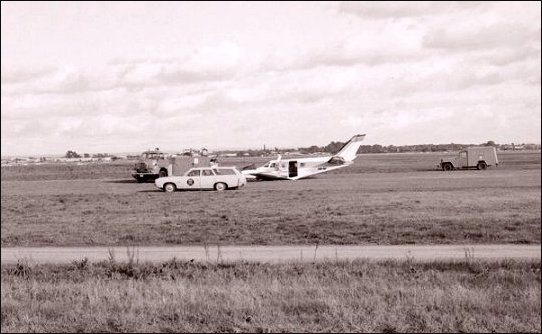
Plane crash landing at Moorabbin Airport, 1975. Leader Collection.
By August, everybody knew that the airfield was to be called Moorabbin Airport. Mr. H.A. McNeice, secretary of the Aero Club said that his members were delighted and added: “To top everything the airport is not to be known officially as Mentone or Cheltenham Airport - nor even Heatherton. The name will be Moorabbin Airport, because Moorabbin is an aboriginal name, while the others names are European. There was, however, another reason why those names could not be used; they would have been duplications of overseas airports and international aviation regulations do not allow two airports to have the same name. Menton(e) Airport was the name of an airport on the French Riviera; Cheltenham in the west of England also had its own airport and Heatherton in an abbreviated form would have read as “Heath" which is the abbreviation for London’s Heathrow Airport.
In September 1949, it was obvious that the airport would soon be open. A letter from the Director General of Civil Aviation forwarded a copy of an order made under the National Security Regulations, prohibiting the erection of any buildings or structure within three miles from the nearest point of Moorabbin Airport without consent in writing of the Director General of Civil Aviation. The council was also asked to submit to the department a building proposal which when completed would violate the 1 in 50 angle to such airport. The meeting agreed that council had no option but to carry out the request and to submit applications for building proposals to DCA. Cr E.A. LePage described the order as “drastic". He pointed out that Cheltenham was within three miles of the airport and so was an aged home where the construction of a new wing was planned.
Another letter from the Department of Works and Housing asked council to construct a section of Grange Road. between Centre Dandenong Road. and the western entrance to the airport at the cost of the Commonwealth, or alternatively to grant the department permission to carry out the work under the supervision of the city engineer. The letter also asked whether council would be prepared to take over and maintain such road when constructed. Council decided that the department be asked to construct the road under the supervision of the city engineer and at the same time be advised that council was not prepared to take over the road when constructed.
October 1949 was the month that interested members of the Australian Labor Party expected to see plans for an elaborate opening of the local airport being put into action, but these did not eventuate. Perhaps Prime Minister Chifley, who was facing a “cheaper and more for all" petrol policy from Liberal leader R. G. Menzies plus a personal attack from the former Labor leader and Premier of New South Wales, Jack Lang, had too much on his mind to give any thought to a lavish opening for an aerodrome
During November the press forgot all about Moorabbin Airport as Chifley defended the need for petrol rationing and Menzies insisted that his policy of putting value back into the pound would see an end to the obnoxious rationing without fuel rising above two shillings a gallon. There were of course other issues being fought out such as nationalisation of banks and a fairer go for housewives. But with petrol ration tickets selling on the black market at two shillings a gallon, almost doubling the price fixed by the Chifley Government, and Australia becoming one of the greatest nations of car owners (per capita) in the world, political observers awaited the arrival of the peak of this country’s three-year election tide, due to eventuate on December 10, 1949.
The result was that Chifley himself struck “dumpers" all the way while Menzies rose higher and higher on the crest of a wave of popularity that he rode to a clear and decisive victory. Exactly a week later Moorabbin Airport came into action without a vestige of ceremony or excitement. Indeed while the airfield was left to get itself off the ground new Members of the House of Representatives were gathering in Canberra where the selection of a new cabinet came as a much greater attraction. Anyhow, who wanted to offer words of praise on an aerodrome that the previous government was responsible for constructing?
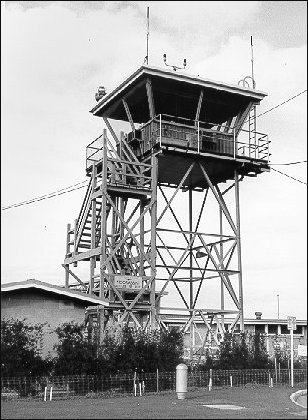
The control tower at Moorabbin Airport, c1970. Courtesy Eric Longmuir.
All that local residents knew about the event came with the delivery of the Moorabbin News on December 16, 1949 (the day before the opening) which simply carried an advertisement lodged by the Department of Civil Aviation calling for applicants for groundsmen, fire crew and watchmen. Annual wages offered for groundsmen and watchmen ranged from £402 to £408 while the fire crew were offered the equivalent of $16.55 a week. Thus Moorabbin Airport had its humble beginning a week after the Menzies Government began to act with a view to putting value back into the pound and a promise that petrol would be plentiful and would not cost more that two shillings a gallon.
By the end of the 1950s Moorabbin Airport had been quietly accepted, so much so that tentative plans to enlarge it to become Melbourne’s first jetport did not meet with as much as a murmur by way of protest. When the overall plan turned up in favour of establishing the jetport at Tullamarine that decision was taken with an equal casualness as if the people did not care one way or another.
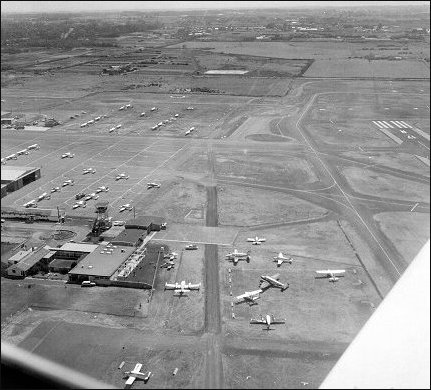
Aerial view of Moorabbin Airport, 1974. Leader Collection.
Footnotes
- First published in the Mordialloc-Chelsea News, April 2, 1980 and Moorabbin News April 8, 1980.
